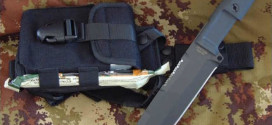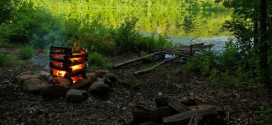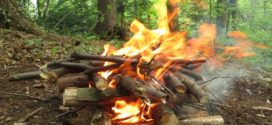In a society with a stable social organization, people get used to a certain level of comfort. Moreover, the definition of the quality of life in different countries is a relative value. The primitive savages that have survived to this day (Africa, the Amazonian jungle) exist in a society with a stable tribal organization and do not seek to live in any other way. And from the point of view of civilized citizens, even the leaders of these savages live much worse than the poorest family in France or Russia. At the same time, all states, as a result of the onset of the social apocalypse, are capable of falling to a lower step in the development of society.
Social apocalypse occurs for various reasons, and it can be conditionally divided into several types:
- Partial Apocalypse
- Resource Apocalypse
- Complete Apocalypse (the same BP or Big P-c)
Content
Partial Apocalypse
This type of decline in society is characterized by the fact that the life support system of cities is temporarily disrupted. Further events develop very sadly.
The delivery of products is interrupted (yes, even Yandex Lavka will not come to you), and industrial goods equipment of the power grid fails, the central heating of residential buildings stops, as well as water supply and gas supply. In a short period of time, power structures are still able to maintain relative order within a disorganized territory. But if life support systems are not restored for a long time, then previously law-abiding citizens begin to organize themselves into gangs. Looting flourishes. The struggle for food, water and places with preserved elements of comfort begins. State power units (army, police) also endure hardships and hardships, soon turning into well-armed and organized gangs. Moreover, units of the security forces begin to compete for vital resources, both with weak civilian gangs and with their colleagues. The unified army of security forces breaks up into territorial units that refuse to obey the capital center. Also, the field commanders of these units cease to care about the protection of citizens who find themselves in their area of responsibility.
Restoring order in such territories is possible only with the establishment of supply systems from the outside and mandatory external control over the distribution of vital resources. A simple delivery of humanitarian aid is not capable of fully restoring society in the territories that have undergone a partial Apocalypse. The resources sent, as a rule, end up in the warehouses of the largest gangs and paramilitary communities. The same is happening with the restoration of infrastructure, which is being recreated mainly at the place of deployment of paramilitary power centers.
The occurrence of a Partial Apocalypse can be due to one of the following reasons:
- Military conflicts between countries
The weak supply of the army at the time of intense conflict leads to the switching of military units to fight for the resources they lack and comfortable places of deployment. This can often be seen in African and Middle Eastern conflicts, where hungry paramilitary communities, instead of holding the front, plunder or go over to the side of a better-off enemy.
- Revolutions associated with internal contradictions
The events of 1917 showed how an irresponsible struggle for power within the ruling elites can significantly bring down the quality of life of citizens in a short period of time.
- Coups d'état provoked from outside
When, with the help of external pressure, stable economic and political ties in society are destroyed, the customers of the revolution, as a rule, do not seek to fully correct the negative consequences of their actions. As a result, a crisis of the stability of the state arises, which can lead to social degradation.
- Revolts in the colonies
The enslavement (in various forms) of one people by another often leads to the resistance of the oppressed population. When the colonial forces are unable to maintain control over the entire colony, they have to concentrate their military garrisons and loyal compradors in a separate territory, the most convenient for holding. The rebellious part, having no single center of subordination and stable supply, is undergoing an internal struggle for power and resources. The civilian population is a hostage to the confrontation of paramilitary rebel groups.
- Natural disasters on a local scale
Hurricanes, tsunamis, droughts, etc. lead either to disruption of supply or to a shortage of food supplies.
Resource Apocalypse
Any state dependent on external supplies may run out of an important resource that made it possible to provide a high standard of living for the elite and an acceptable existence for ordinary citizens. In the foreseeable future, such a prospect is not excluded in modern resource-dependent states.
The internal capabilities of import-dependent states do not allow them to meet their needs for food, machinery and manufactured goods. The budgets of such countries are filled mainly from foreign exchange earnings. When the foreign exchange inflow dries up, there is an acute shortage of all imported goods.
Unlike the Partial Apocalypse, resource hunger destroys society slowly. Administrative and law enforcement agencies are trying to maintain control over society, which is criminalized in proportion to the fall in living standards. At a certain point, state structures deplete their resources and lose personnel so much that they lose their monopoly on violence. Unrest and riots begin.
Relatively self-sufficient territories of the country are under the control of paramilitary communities. At the same time, the social organization of society falls to the level of the Middle Ages. And the inhabitants of lands with scarce food resources are doomed to poverty, chaotic migration, hunger and degradation. The population of endangered territories will inevitably decrease to the amount that these lands are able to provide in basic needs (food, water). After that, a period of stability begins, and the degradation of social relationships stops.
The causes of the Resource Apocalypse may be the following factors:
- Depletion of sources of exportable natural resources or refusal by other countries to buy them
If the oil fields in the Middle East run out, or the industrial countries switch from oil consumption to alternative energy sources, then the eastern sultanates will find themselves in a very unenviable position. The elites spoiled by luxury are unlikely to want to feed their own population from their personal foreign exchange reserves for a long time. Most likely, the ruling class will simply run away from their homeland, having previously sent all the currency from the state budget to their foreign bank account and taking compact valuables with them.
- Supply sanctions (embargo)
This type of resource Apocalypse in a light version was experienced by Venezuela not so long ago. In the presence of huge oil reserves, the US ban on the disposal of the proceeds from the sale of Venezuelan oil could well lead to mass starvation and the destruction of statehood. Only the help of a number of countries stopped the apocalyptic scenario for Venezuela.
- Degradation of management decisions of the government
When, after the collapse of the USSR, the ruling group of reformers began to systematically liquidate the industry and agriculture of Russia, tens of millions of citizens were left without work and wages in a short period of time. The administration, the army and the police in Yeltsin's Russia have not disappeared anywhere. However, an overabundance of unemployed citizens, multiplied by the stupidity of the top authorities, forced the population to survive by any available means. Banditry and the seizure of power by criminal communities in economically active cities were the result of one of the varieties of the Resource (labor) Apocalypse in Russia.
- energy crisis
In the absence of energy supplies (gasoline, coal), all transport and cargo communications are disrupted, and power outages begin. Store shelves are empty, businesses are shutting down, and it is not possible to leave million-plus cities for the countryside. Something similar in a simplified version happened in a number of countries during the energy crisis of 1973. For example, in the United States, shortages in gasoline in the long run could well unbalance the economy and lead the country to a new Great Depression. Fortunately for the Americans, the crisis did not last long. And the US government then switched its attention from the anti-communist struggle in Asia to control over the oil-bearing countries.
Complete apocalypse
This is the most terrible kind of social decline, in which the entire state apparatus of administration and supply is destroyed at the same time on the territory of a state (or groups of states).
Staying in big cities becomes dangerous. Those who try to stray into large communities of people are doomed to death. Only small groups survive, which are distributed throughout the area of the former state and try to stay away from large, starving communities and gangs. If a complete apocalypse occurs in a separate area, then it will be most practical to simply relocate a significant part of the survivors to areas unaffected by the phenomenon that caused the destruction of society. Even under very terrible conditions of global catastrophes, there are always islands of life that are able to provide relatively large communities of survivors with everything they need. A similar kind of apocalypse can be caused with the following factors:
- Nuclear disaster
Infected lands are not able to produce healthy food for a long time.
Poisoned food and radiation finish off those who did not die from a nuclear explosion or a powerful leak from a nuclear reactor.
- virus pandemic
Mass mortality from an infectious disease can lead to the fact that the size of the population remaining in the extinct territory will not allow people to maintain a civilized way of life. Small communities quickly run wild, and already in the second generation they will degenerate through incest and the weakness of medicine. In order to preserve the opportunities that contribute to the revival of civilization, surviving people with acquired immunity must gather in at least one large community of at least 10,000 people.
- global natural disaster
Flooding of large areas of land, a shift in the Earth's orbit, a collision with a large space body, the awakening of volcanoes and other natural disasters can create very uncomfortable conditions for the survival of mankind.
- Global ecological catastrophe
Socially irresponsible activities of industrial corporations can poison the air, water, soil and disrupt the ecological balance in a large part of the planet.
A Guide to Surviving a Social Apocalypse in an Urban Environment
Essential item for survival
Stereotypical perception leads people to believe that the most important thing for surviving during a social apocalypse is having a weapon in the house or a supply of food. In fact, the main subject after a power outage and communications is ... portable radio .
A different type of extreme situation involves a separate tactic of behavior. In some cases it is better to survive alone, in others under the protection of armed groups, in others it is better to stay put and wait for help. A man without equipment , but with information about the state of affairs, is in a better position than an equipped survivalist who does not understand the essence of the events taking place around him. During the disappearance of electricity and food in stores, the survivalist is quite capable of deciding that the Complete Apocalypse has come. And his aggressive behavior during the period of anarchy may, after stabilization of the situation, lead him to the dock. The opposite situation will arise if the survivalist underestimates the degree of the extreme situation and chooses a passive line of behavior.
The radio receiver is a necessary thing for making the right decisions when developing tactics for your behavior. If the switched on equipment continues to catch music and radio transmissions, then the disconnection of communications and electricity is not a global event. Radio news and rescuers' conversations intercepted on the air help the survivalist to navigate the situation and correct his behavior.
Food and water
For an urban family, a huge supply of food is not only useless, but also dangerous. With the system of public order destroyed, the apartment is only a safe haven for some time. The experience of protracted military conflicts and social degradation during natural disasters has clearly shown this. After three or four days of anarchy, professional looters show up, driving trucks to houses and shops. They break down doors, crush any resistance and take out valuables. As a rule, these groups of marauders are formed from local criminals. A few days later, most of the townspeople run out of food. Some previously law-abiding citizens organize themselves into mobile gangs (3-5 people each) and begin to break into other people's apartments in search of supplies. Having a firearm in the house will help hold your food supply for a week or two. But sooner or later, the family mini-warehouse will be in the hands of one of the gangs. So it is most rational for urban residents to keep a supply of food and water at the rate of no more than two weeks. After 7-10 days of anarchy in the city, it is better for the family to pack everything necessary for survival outside of civilization and leave the dangerous city limits at night.
Weapon
The ban on weapons in the USSR arose in the post-war period. The number of domestic deaths and accidents from registered and captured weapons forced the Soviet government to tighten the rules for owning pistols and shotguns. In the event of the destruction of statehood, crime and dashing gangs become the most armed groups in the city. In the 1990s, Russian cities experienced this in full measure. Weapons were stolen from warehouses, written off by officers and exchanged for elementary food. As a result, in an average Russian city, several dozen poorly armed law enforcement officers accounted for hundreds and even thousands of militants from various criminal groups. With a more serious destruction of society, self-organized gangs are able to act even tougher and more brazenly than in early post-Soviet Russia. Any single owner of a firearm becomes a target for gangs seeking to increase their rogue arsenal and ammunition. Therefore, if you have hunting rifle , it is better to hide or disguise it. For example, you can make a safe for weapons yourself.
For short-range self-defense, ordinary piercing and cutting objects are quite suitable as weapons: knife, pointed stick, etc. An analysis of the survival of people at the time of a temporary social apocalypse showed that an unprepared person is more likely to survive without lethal weapons than with them. In the warring African countries, the civilian population is literally crammed with various types of obsolete firearms and explosives. However, African residents mostly die not when trying to protect their property, but from banal crossbows and self-explosions.Equipment for getting out of the city
When a family or a lone prepper determines that it is dangerous to remain in the city, then the question arises of moving to a quieter place. It is safe to get out of the city by transport only in the first days after the onset of the social apocalypse. Later, the gasoline in the car's tank will become a target for marauders, and trying to slip through ambushes can cost a life. It is best to walk out of the city at night, without lanterns and illumination devices. It is necessary to make your way to safe places not directly along the roads, but in parallel with them. This makes it possible to go unnoticed by mobile marauders. The weight of the equipment carried must be acceptable for a long journey. It is recommended to take the following items with you on the road:
- Warm and waterproof clothing
Even if the summer heat is on the street, it will not save the survivalist either from nighttime hypothermia or from sudden and prolonged rain. Clothing on a person should be comfortable and light. A jacket with a hood is preferable to other types of outerwear. Additional insulation (sweater, underpants, mittens, scarf, compact blanket) is best hidden in waterproof bags.
Before going out, put on shoes in plastic bags and cover them with tape. This will protect the shoes from moisture if they get into a deep puddle or washed out mud. Socks must be of two types: durable for movement and insulated for spending the night.
- Tent or materials for its imitation
Not everyone in the house has a tourist tent or a sleeping bag available. Therefore, you need to attend to the possibility of deploying a semblance of a tent in places where there are no suitable shelters for recreation. Duvet covers and curtains are suitable as materials for the quick deployment of a homemade tent. It is better to build a single shelter in the form of a wigwam on three sticks. A family fleeing the city has the opportunity to take more material for shelter, and a tent covered with several layers of fabric will be better protected from wind, rain and insects. It is important to know that there should be at least five centimeters of any flooring between the damp earth and the body. It is also not recommended to build a fire in a tightly closed tent. Lighting a small fire is allowed only when the "roof" of the tent is removed.
- Two knives
The largest knife is necessary for rough work and self-defense. For more delicate work, you will need a small knife with a well-sharpened blade.
- Attributes for kindling a fire
A lighter on a long journey is more preferable than unreliable matches that go out in the wind and can become damp. To light wet brushwood (after rain), you must have toilet paper or newspaper with you.
- Products
A large amount of food, thoughtlessly placed in a bag, will significantly reduce the survivalist's mobility. It is much more rational to take a compact supply of energy-intensive products (stew, sugar, sweets) and move to a safe area with a moderate load on your back.
- Means for filtering and boiling water
It is recommended to take water in two one and a half liter bottles, no more. After emptying the first bottle, the bottom is cut off, after which it becomes a container for filtering water from puddles. Any clean piece of cloth can be used as a filter. Separated from large grains of sand, water should boil well on fire before use. To do this, you need to take a metal bowl or a small saucepan on a hike.
When moving in the dark or in swampy areas, a group of survivalists must tie themselves with a rope. Ropes are also used in the construction of temporary shelters. In a city apartment, a wire from an extension cord and cords from electrical appliances can be a good substitute for a rope. The length of the rope (or its imitation) must be at least 3 meters per person.
- first aid kit
On a long trip, a survivalist cannot avoid corns on his feet, cuts and night cold. The first aid kit must be equipped with appropriate medical supplies. A clean bandage, alcohol solution, iodine, boric acid or Rescuer ointment will help out the survivalist in case of injuries and cuts. If there are cold, antipyretic and analgesic drugs available, then they must also be taken with you.
A professional survivalist, finding himself in an unfamiliar area, is able to recreate any of the above items from the elements of the environment with his bare hands. In contrast, an untrained urban dweller in the open can only rely on his equipment. A city dweller accustomed to comfort can adapt to eating without a spoon, not bathing for weeks, and wearing shabby clothes. However, without basic tools and things for survival, the average city dweller is doomed to death when society is destroyed.
Conclusion
World wars, revolutions and viral pandemics have tested humanity for strength more than once. A sharp social degradation of the social structure can catch a person anywhere on the planet. Knowing the signs of the coming apocalypse and the ability to distinguish it from a simple social crisis saves the prepper from irrational actions. In our turbulent world, the ability to correctly assess the environment is a vital skill. And understanding a person how to act in an extreme situation can save his health and life.
Hello, I am Alexander, the mastermind behind the blog.
In terms of career and free time, I connected my life with the forest. How else, when you live in Karelia! In this blog, I am responsible for the hunting, hiking and equipment sections. Welcome to my world!
 Survival Lessons Tips for the survivalist, fisherman and hunter
Survival Lessons Tips for the survivalist, fisherman and hunter





